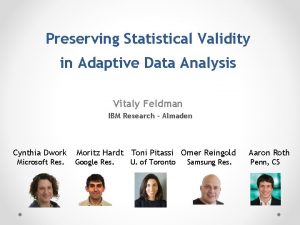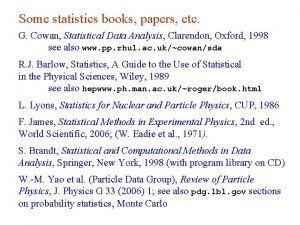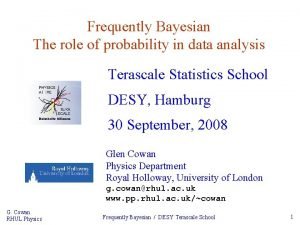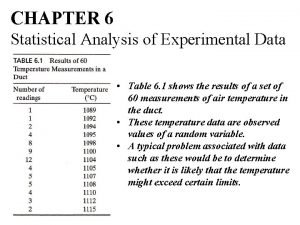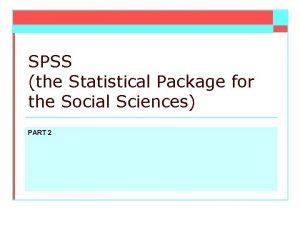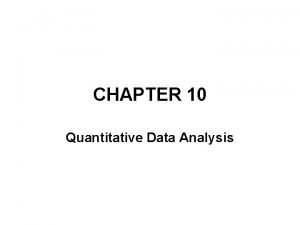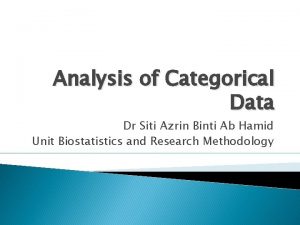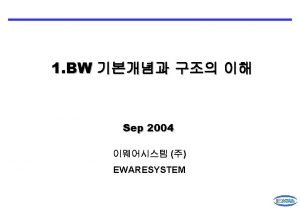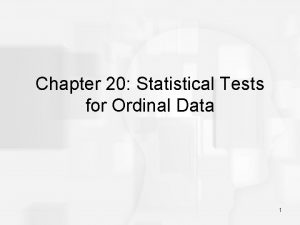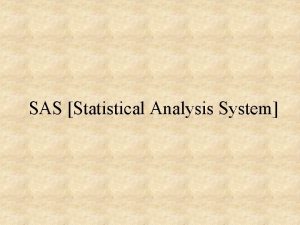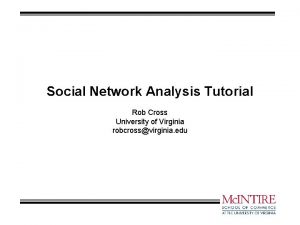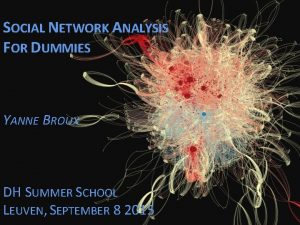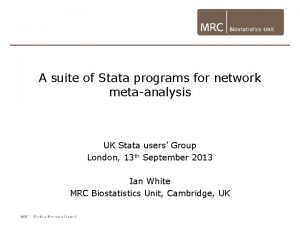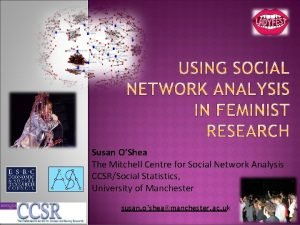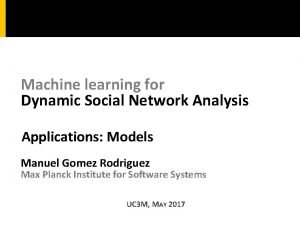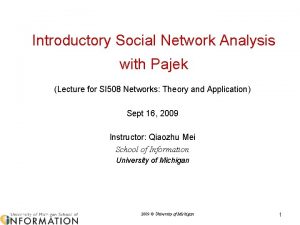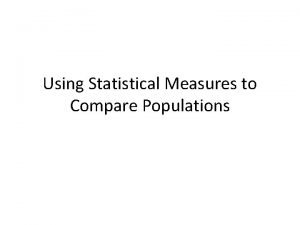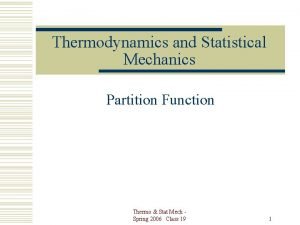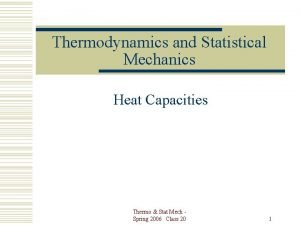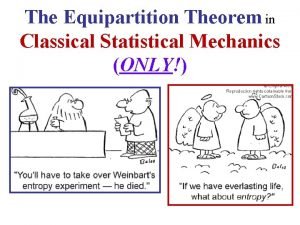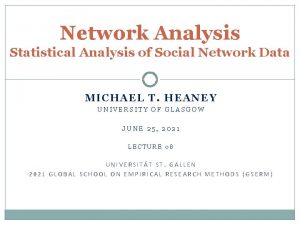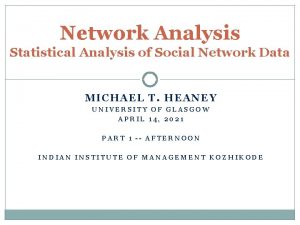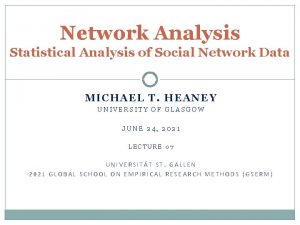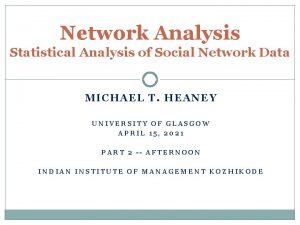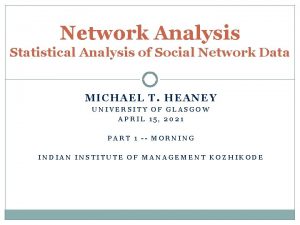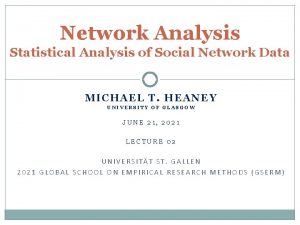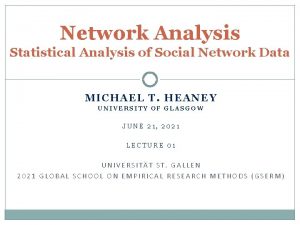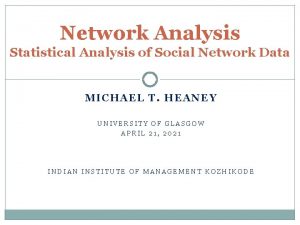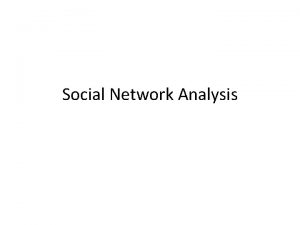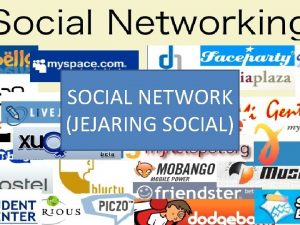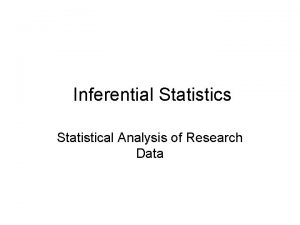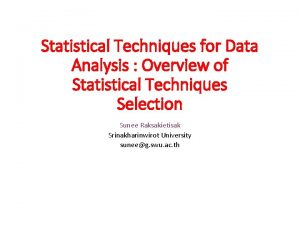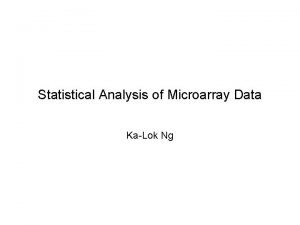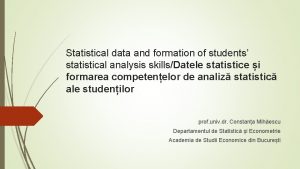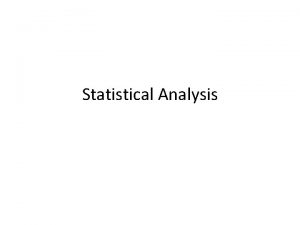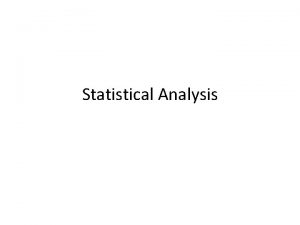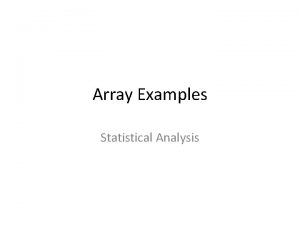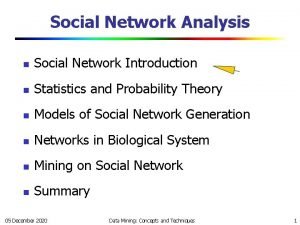Network Analysis Statistical Analysis of Social Network Data































- Slides: 31

Network Analysis Statistical Analysis of Social Network Data MICHAEL T. HEANEY UNIVERSITY OF GLASGOW APRIL 13, 2021 PART 2 -- AFTERNOON INDIAN INSTITUTE OF MANAGEMENT KOZHIKODE

Research Design and Data

Research Design and Data Whole Networks vs. Ego Networks Boundary Specification Questionnaire Design Data Formats

Whole Networks vs. Ego Networks

Whole Networks vs. Ego Networks �Whole networks – observer has information about all nodes and links in the network – all network-level statistics can be computed

Whole Networks vs. Ego Networks �Whole networks – observer has information about all nodes and links in the network – all network-level statistics can be computed �Ego Networks – observer only has information about the links to a sample of the nodes – networklevel statistics cannot be computed – e. g. , we know about the properties of the first-degree contacts, such as sex, age, etc.

Whole Networks vs. Ego Networks �Whole networks – observer has information about all nodes and links in the network – all network-level statistics can be computed �Ego Networks – observer only has information about the links to a sample of the nodes – network-level statistics cannot be computed – e. g. , we know about the properties of the first-degree contacts, such as sex, age, etc. �It is not the networks themselves that differ, but our ability to collect information about them.

Whole Networks vs. Ego Networks �Whole networks – most common in the study of elites and institutions, as well as computer networks. �Ego Networks – most common in the study of individual behavior

Whole Networks vs. Ego Networks �Whole networks – all network analysis techniques can be used �Ego Networks – analysis techniques involve analysis of the alters of focal persons

Snowball Sampling �Snowball sampling creates an intermediate network that is somewhere between an ego network and a whole network. Procedure: 1. Select a random sample from the population 2. Ask each respondent in the random sample about network alters. 3. Contact those alters and request information on those alters. 4. Contact the alters of the alters. 5. Continue….

Problems with Snowball Sampling �Snowball sampling selects a sample on the basis of the network structure. �As a result, snowball sampling yields networks that appear to be more closely connected and cliquey than they really are. �Snowball sampling inherently has huge selection bias problems

Legitimate Uses of Snowball Sampling � Snowball sampling may be useful if the statistical models account for the snowballing in the estimation process (i. e. , respondent-driven sampling) � This method may be especially effective in studying small populations when the snowballing exhausts the total population (i. e. , there is no selection bias if the entire population is selected). � May work for political elites, IV-drug users. � Douglas D. Heckathorn, "Respondent-Driven Sampling: A New Approach to the Study of Hidden Populations, " Social Problems (1997).

Boundary Specification �Edward O. Laumann et al, “The Boundary Specification Problem in Network Analysis. ” In Research Methods in Social Network Analysis (1989). �Networks do not have “natural” boundaries. �Networks are constructed by the researcher with a research purpose in mind. �Best practice is to use multiple, “objective” data sources to identify nodes for analysis.

Questionnaire Design

Take Out a Sheet of Paper (not turned in) �Write down the names of your closest friends. �Write down the names of people who you talk to about politics. �Write down the names of the people you drink beer with. �Write down the names of the people you have been on a date with in the last year. (Use initials if you like. )

Goals for Measuring the Network �Whole Network – attempting to look at how every actor is connected with every other – small social systems �Ego Network – attempting to look only at part of the network – perhaps, what are the kinds of people you are connected with (e. g. , how many of your friends are men, women) – large social system

Two Basic Question Formats �Fixed List (analogous to closed-ended questions) �Name generator (analogous to open-ended questions)

Fixed List

Name Generator See Merrill Lynch survey.

Fixed list: Advantages / Disadvantages �Advantages -- People are less likely to “forget” social ties -- Clearly defined network boundaries -- Works well when the social system is small or when analyzing elites -- Usually the approach when measuring whole network (but not always)

Fixed list: Advantages / Disadvantages �Disadvantages -- Important network contacts may not be on the list -- Difficult and time-consuming to go through entire list (fatigue effects) -- Real network may be ill defined -- Must have the “whole list” – works only in small networks – or elite networks

Name Generator: Advantages / Disadvantages �Advantages -- Flexibility: people can name anyone they like -- Efficiency: it is easy to ask for a large amount of information in a small space -- Efficacy: Accommodates large social networks -- Usually the approach when measuring ego networks (but not always)

Name Generator: Advantages / Disadvantages �Disadvantages -- Forgetting is a major problem -- Variance from person to person in threshold for listing -- Measuring network degree may be highly unreliable

Tricks for Name Generators �Constrain the number of alters list (e. g. , name your top three best friends) – highly problematic because it artificially constrains network degree �Multiple asking of the same (or similar) question �Allow respondents to revise their answers. �Prompt people with something concrete (e. g. , who do you meet for coffee rather than who are your friends)

Types of Questions �Existence of Ties (e. g. , Who are your friends? ) �Frequency of ties (e. g. , How often do you meet? ) �Evaluation of ties (e. g. , Who is your best friend? Who is most influential? ) �Types of ties (e. g. , What types of people are you tied to? Are your friends old, young, poli sci majors? )

Data Formats: Edgelist vs. Adjacency Matrix

Data Formats Adjacency Matrix / Spreadsheet A B C D A 1 0 B 0 1 C 1 0 -- GOOD FOR SMALL NETWORKS D 0 1 Edgelist – GOOD FOR LARGE NETWORKS AC BD EF An adjacency matrix can be converted to an edgelist, and vice versa

A Real Edgelist

A Real Adjacency Matrix

Ethical Considerations �Some network data may not be easily anonymized �Is it legitimate to use network data for commercial purposes?

Questions / Comments ?
 Preserving statistical validity in adaptive data analysis
Preserving statistical validity in adaptive data analysis Cowan statistical data analysis
Cowan statistical data analysis Cowan statistical data analysis pdf
Cowan statistical data analysis pdf Statistical analysis of experimental data
Statistical analysis of experimental data Statistical package for social science
Statistical package for social science Social thinking adalah
Social thinking adalah Social thinking social influence social relations
Social thinking social influence social relations Data collection in research example
Data collection in research example What statistical test for categorical data
What statistical test for categorical data Statistical data warehouse
Statistical data warehouse Statistical tests for ordinal data
Statistical tests for ordinal data Statistical treatment of data example
Statistical treatment of data example Statistical analysis system
Statistical analysis system Ascenex
Ascenex Multivariate statistical analysis
Multivariate statistical analysis Statistical business analysis
Statistical business analysis Conjoint analysis in r
Conjoint analysis in r Social network analysis tutorial
Social network analysis tutorial Social network analysis for dummies
Social network analysis for dummies Stata network analysis
Stata network analysis Susan o shea
Susan o shea Machine learning social network analysis
Machine learning social network analysis Pajek
Pajek Research procedure in methodology
Research procedure in methodology Data preparation and basic data analysis
Data preparation and basic data analysis Data acquisition and data analysis
Data acquisition and data analysis Content analysis secondary data
Content analysis secondary data Government statistical service
Government statistical service Using statistical measures to compare populations
Using statistical measures to compare populations Stat
Stat Statistical mechanics
Statistical mechanics Equipartition theorem proof
Equipartition theorem proof
